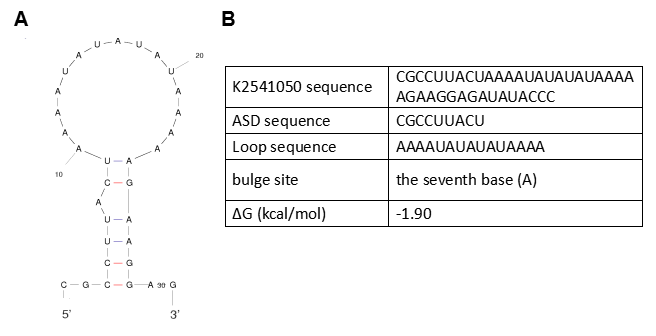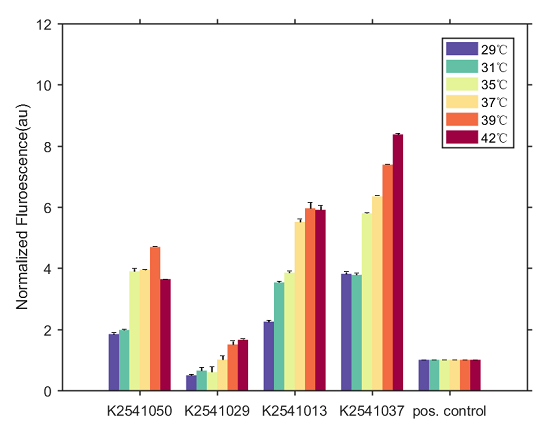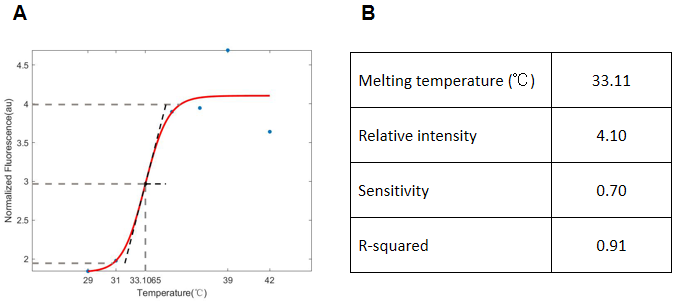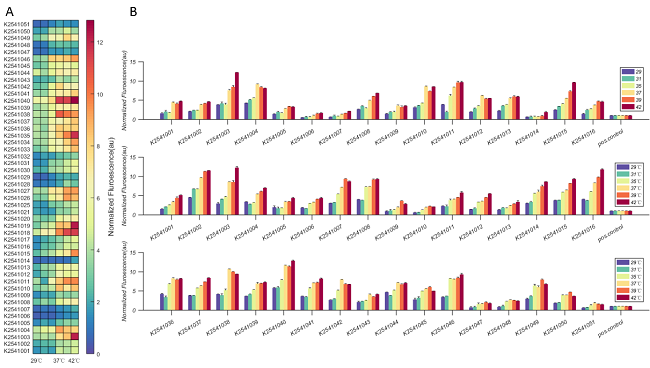Part:BBa_K2541050
Heat-inducible RNA-based thermosensor-50
A RNA-based thermosensor that can be used for temperature sensitive translational regulation which is based on the change of RNA sencondary structure. The heat-inducible RNA-based thermosensors can initiate translation of downstream genes at high temperatures.
1. Usage and Biology
Heat-inducible RNA-based thermosensors are RNA genetic control systems that sense temperature changes. At low temperatures, the mRNA adopts a stem-loop conformation that masks the Shine–Dalgarno (SD) sequence within the 5’-untranslated region (5’-UTR) and, in this way, prevents ribosome binding and translation. At elevated temperatures, the RNA secondary structure melts locally, thereby giving the ribosomes access to the SD sequence to initiate translation (Figure 1). Whereas natural RNA-based thermosensors have a relatively complicated secondary structure with multiple stems, hairpin loops and bulges which impeds application process.
Our team designed synthetic heat-inducible RNA-based thermosensors that are considerably simpler than naturally occurring thermosensors and can be exploited as convenient on/off switches of gene expression.
Figure 1. Mechanism of heat-inducible RNA-based thermosensors.
2. Design
The heat-inducible RNA-based theromsensors are designed on the basis of the melting temperature of the minimum free energy structure, consisting of ASD (anti-SD) sequence, loop sequence and consensus SD sequence (5’-AAGGAG-3’). To optimize the thermosensors for the desired melting temperature, intensity and sensitivity, three structural parameters come into consideration: stem length, loop size and mismatches or bulges in the stem.
Stem length is determined by ASD sequence because the SD sequence is conserved. Adding stem length can optimize heat-inducible RNA-based thermosensors to more high temperature, while decreasing stem length has the opposite effect. The stem length is 7 base parings in K2541050. Loop size can moderate thermosensors melting temperature to a suitable temperature. In K2541050, the loop sequence is AAAAUAUAUAUAAAA. Furthermore, we make a bulge in the seventh base by inserting A. Finally, we get the sequence as the figure 2B. After designing, the theromsensor sequence is predicted by computational methods mFOLD to get its minimum free energy and secondary structure (figure 2).
Figure 2. Design of K2541050. (A) The RNA secondary structure is predicted by mFOLD. (B) Thermosensor sequence, ASD sequence, loop sequence, the site of mismatch or bulge in the stem and ΔG are in the table.
3.Characterization
3.1 Measurement device
The thermosensor sequence is constructed on the pSB1C3 vector by Golden Gate assembly. The measurement device is composed of Anderson promoter (BBa_J23104), thermosensor (BBa_K2541050), sfGFP_optimism (BBa_K2541400) and double terminator (BBa_B0010 and BBa_B0012). We select a constitutive Anderson promoter J23104 as an appropriate promoter by pre-experiment. The sfGFP_optimism has faster folding speed and higher fluorescence intensity. The double terminator can reduce leakage (Figure 3). We characterized RNA-based thermosensors in E.coli DH5a.
3.2 Measurement results
K2541050, K2541029, K2541013 and K2541037 are four different heat-inducible RNA-based thermosensors. pos.control is positive control. The final normalized fluorescence was calculated as follows: normalized fluorescence = [(Fluorescence/Abs600)TS - (Fluorescence/Abs600)neg] / [(Fluorescence/Abs600)pos - (Fluorescence/Abs600)neg] ( TS = thermosensor, pos = positive control, and neg = BBa_J364007 ). As shown in figure 4, the fluorescence intensity of K2541050 increases with elevated temperature.
Figure 4. Characteristics of K2541050. Each set of six bars represents the activity level of a different thermosensor. The bar colors purple, aquamarine, light green, orange, red and brown represent the temperatures 29, 31, 35, 37, 39 and 42°C, respectively. The height of the bars corresponds to the normalized fluorescence.
3.3 Thermodynamic analyses
This year, our project is to design a collection of RNA-based thermosensors with different melting temperatures, intensity and sensitivity. We used a combination of experimental measurements and computations of RNA secondary structures. We studied a set of measured synthetic RNA-based thermosensors, finding consistency among our experimental and computational analyses.
Figure 5. Temperature response of the heat-inducible RNA-based thermosensor. (A) The red solid line represents the activity of the RNA-based thermosensor as a function of temperature. (B) Key quantitative features such as melting temperature, relative intensity, sensitivity and R-squared are in the table.
4. Collection of heat-inducible RNA-based thermosensors
Figure 6. Experimental measurements of the collection of heat-inducible RNA-based thermosensors show a variety of responses. (A) Rows represent activity levels of different thermosensors. (B) Each set of six bars represents the activity level of a different thermosensor. The bar colors purple, aquamarine, light green, orange, red and brown represent the temperatures 29, 31, 35, 37, 39 and 42°C, respectively. The height of the bars corresponds to the normalized fluorescence.
5. Conclusion
Our data show that efficient RNA-based thermosensors with different melting temperatures, intensity and sensitivity can be built from a single small RNA stem-loop structure masking the SD sequence, thus providing useful SynRT toolkit for the regulation of gene expression.
Sequence and Features
- 10COMPATIBLE WITH RFC[10]
- 12COMPATIBLE WITH RFC[12]
- 21COMPATIBLE WITH RFC[21]
- 23COMPATIBLE WITH RFC[23]
- 25COMPATIBLE WITH RFC[25]
- 1000COMPATIBLE WITH RFC[1000]
| None |





